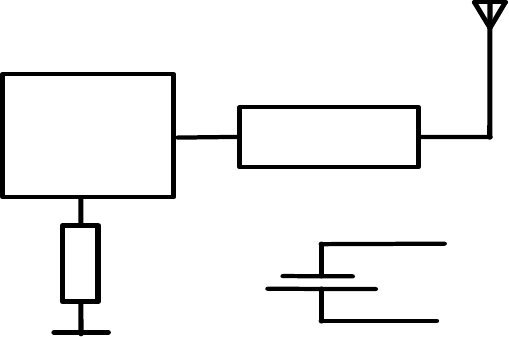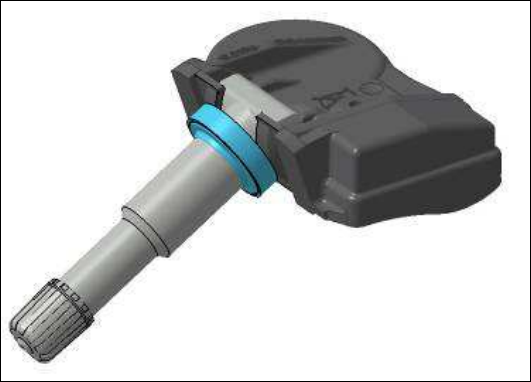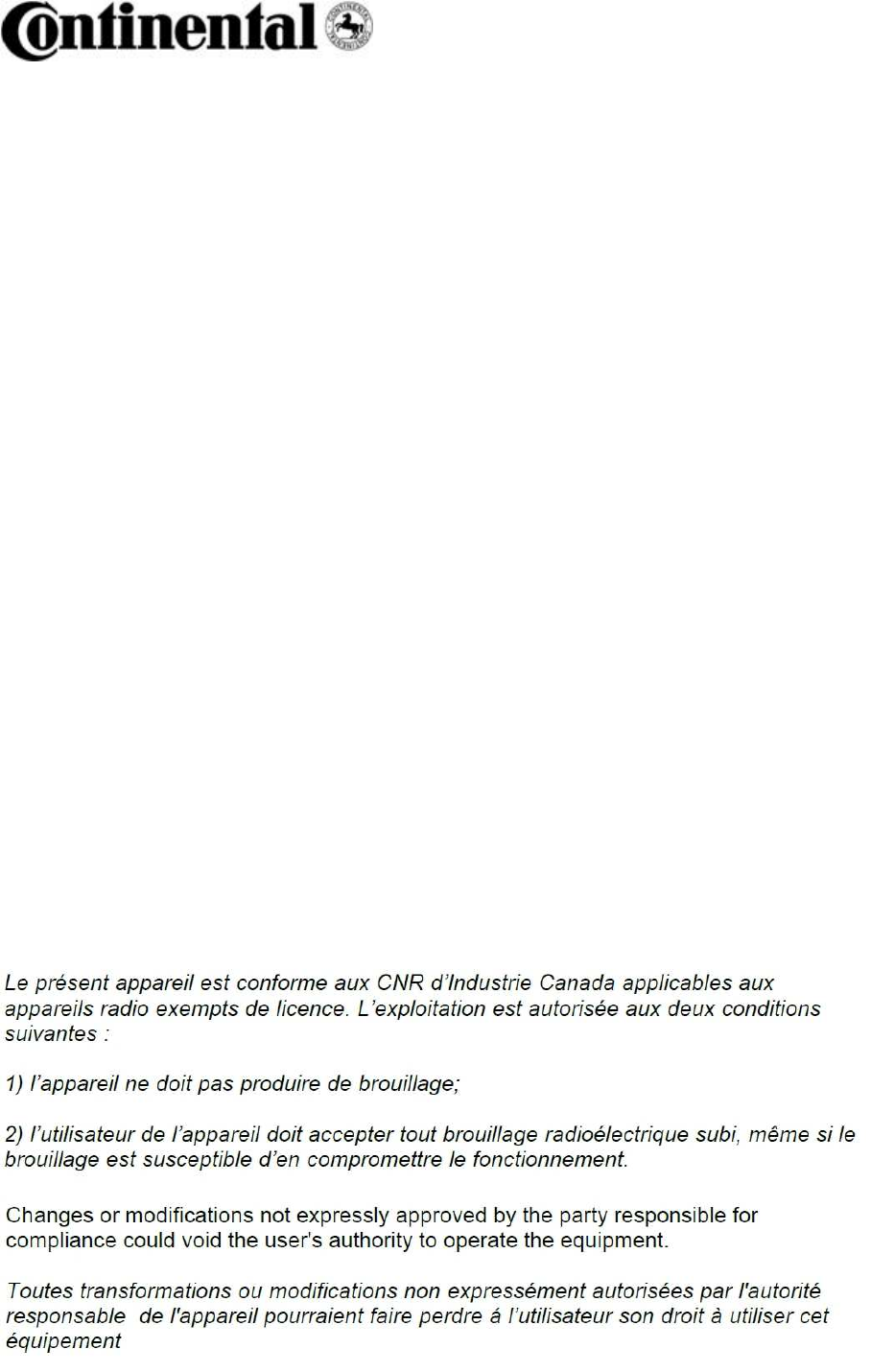Continental Automotive TIS-02 Tire Pressure Monitoring System User Manual S180245003 AR JLR Functional description
Continental Automotive GmbH Tire Pressure Monitoring System S180245003 AR JLR Functional description
User Manual
Continental Automotive
1 of 6
User Manual / Functional Description
of the
Continental
Tire Pressure Wheel Unit
Type
TIS-02 315MHz

Continental Automotive
2 of 6
1. SYSTEM OVERVIEW
Tire pressure monitoring system (called also TG for Tire Guard) is composed by:
- a tire guard wheel unit including an integrated pressure, temperature and acceleration sensor
and a RF transmitter.
- a RF receiver unit (not described in this document)
TG monitors the pressure of vehicle tire when driving or when it is stopped. An electronic unit
(wheel unit) mounted inside the tire periodically measures the current pressure. Thanks to a RF
link, this pressure information is transmitted to the RF receiver/decoder.
2. TECHNICAL DESCRIPTION
Carrier frequency: 315MHz (± 32 kHz)
Frequency FSK deviation: ± 40 kHz
Number of channels: 1
Type of modulation: Frequency Shift Keying (FSK)
Baud rate: 9600 bds
Rated Output Power: < 10mW
Antenna: Internal
Voltage supply: 1 Lithium battery 3V (CR2450)
Voltage supply range: 2.1 up to 3.2V
3. TYPICAL USAGE PATTERN
3.1 AVERAGE FACTOR CALCULATION (Standard 47 CFR Part 15C (periodic
intentional transmitter))
RF frames maximum duration = 10.3ms
Averaging factor = 20 x log (10.3/100) = -19.7dB

Continental Automotive
3 of 6
4. BLOCK DIAGRAM
The block diagram below shows the main electronic units of the wheel unit:
3V
LIT H IUM
BAT TERY
Learning coil
RF C IR CU IT
ANTE N NA
Pressure,
tem perature,
acceleration
sensor and
µcontroller

Continental Automotive
4 of 6
5. PICTURES

5 of 6
FCC/IC Regulatory notices
Modification statement
“Continental” has not approved any changes or modifications to this device by the user. Any
changes or modifications could void the user’s authority to operate the equipment.
“Continental” n’approuve aucune modification apportée à l’appareil par l’utilisateur, quelle
qu’en soit la nature. Tout changement ou modification peuvent annuler le droit d’utilisation
de l’appareil par l’utilisateur.
Interference statement (if it is not placed in the device)
This device complies with Part 15 of the FCC Rules and Industry Canada licence-exempt RSS
standard(s). Operation is subject to the following two conditions: (1) this device may not
cause interference, and (2) this device must accept any interference, including interference
that may cause undesired operation of the device.
Le présent appareil est conforme aux CNR d'Industrie Canada applicables aux appareils
radio exempts de licence. L'exploitation est autorisée aux deux conditions suivantes : (1)
l'appareil ne doit pas produire de brouillage, et (2) l'utilisateur de l'appareil doit accepter
tout brouillage radioélectrique subi, même si le brouillage est susceptible d'en compromettre
le fonctionnement.
Wireless notice
This device complies with FCC/IC radiation exposure limits set forth for an uncontrolled environment and meets the FCC
radio frequency (RF) Exposure Guidelines and RSS‐102 of the IC radio frequency (RF) Exposure rules. This transmitter must
not be co-located or operating in conjunction with any other antenna or transmitter.
Le présent appareil est conforme à l'exposition aux radiations FCC / IC définies pour un environnement non contrôlé et
répond aux directives d'exposition de la fréquence de la FCC radiofréquence (RF) et RSS
‐
102 de la fréquence radio (RF) IC
règles d'exposition. L'émetteur ne doit pas être colocalisé ni fonctionner conjointement avec à autre antenne ou autre
émetteur.
FCC Class B digital device notice
This equipment has been tested and found to comply with the limits for a Class B digital device, pursuant to part 15 of the
FCC Rules. These limits are designed to provide reasonable protection against harmful interference in a residential
installation. This equipment generates, uses and can radiate radio frequency energy and, if not installed and used in
accordance with the instructions, may cause harmful interference to radio communications. However, there is no guarantee
that interference will not occur in a particular installation. If this equipment does cause harmful interference to radio or
television reception, which can be determined by turning the equipment off and on, the user is encouraged to try to correct the
interference by one or more of the following measures:
- Reorient or relocate the receiving antenna.
- Increase the separation between the equipment and receiver.
- Connect the equipment into an outlet on a circuit different from that to which the
receiver is connected.
- Consult the dealer or an experienced radio/TV technician for help.
CAN ICES-3 (B) / NMB-3 (B)
This Class B digital apparatus complies with Canadian ICES-003.
Cet appareil numérique de classe B est conforme à la norme canadienne NMB-003.

6 of 6
3. LABEL INFORMATION
1.1. USA
Continental
TIS-02
FCC ID: KR5TIS-02
This device complies with Part 15 of the FCC Rules. Operation is subject to the following
two conditions: (1) this device may not cause harmful interference, and (2) this device
must accept any interference received, including interference that may cause undesired
operation.
Changes or modifications not expressly approved by the party responsible for
compliance could void the user's authority to operate the equipment.
1.2. CANADA
Continental
TIS-02
IC: 7812D-TIS02
Operation is subject to the following two conditions: (1) this device may not cause
harmful interference, and (2) this device must accept any interference received, including
interference that may cause undesired operation.
Changes or modifications not expressly approved by the party responsible for
compliance could void the user's authority to operate the equipment.